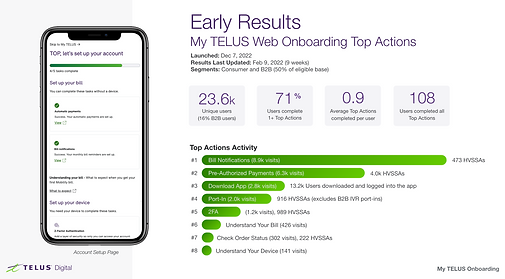OPTIMIZING SELF-SERVE CAPABILITIES:
CUSTOMER ONBOARDING JOURNEY

At TELUS, I led cross-functional teams to define the initial scope of work for the digital Onboarding journey aimed at enhancing consumer experience. This scope of work included data analysis, short- and long- term strategies, roadmap planning, and the optimization of TOP engaging self-serve features.
As the program evolved, it expanded to support both consumer (B2C) and business (B2B) experiences. With this shift in program strategies, my role as the lead for the Onboarding program evolved to focus on optimizing TOP features both before and after the Onboarding Journey. Under my portfolio, I managed essential features such as Login & Registration, Profile Management, and Two-Factor Authentication (2FA).
The primary goal was to encourage customers to utilize these TOP features during their initial account activation through the Onboarding journey and complete their profile settings before the first billing cycle.



MY ROLE
-
Implemented MVPs for customer-centric designs and content updates to enhance user interactions. Validated the team's hypothesis, creative and critical decisions.
-
Coordinated workshops to identify market trends, analyze competitor strategies, and assess feature performance.
-
Optimized product features by redefining KPIs based on in-depth customer behavior analysis.
-
Revamped the communication funnel and enhance awareness messaging.
-
Facilitated stakeholder meetings to ensure the roadmap is aligned with business objectives and goals.
-
Provided performance metrics to identify areas for continuous improvement.


WHAT'S THE PROBLEM?
The Onboarding program evolved beyond just design and content updates. Initially, we hypothesized that customers would complete their first login within the first 7 days of Onboarding. However, we discovered that the initial login often extended to 30 days, coinciding with the notification about their first billing cycle.
To gain deeper insights into our user experience, we conducted research on TOP actions and call drivers within the first 30 and 60 days. This led to adjustments in our originally determined key performance indicators (KPIs).
Our continuous improvement team collected customer feedback and validated it against quantitative measurements. We found that 46% of customers called in for support due to unclear Onboarding messages (email, SMS, app) via communication funnel. Additionally, customers found the user workflow cumbersome to navigate within certain TOP features. As a result, our business goal became reducing the number of customer support calls within the first 30 days of a new product and service activation, ideally before first billing cycle.


WHAT'S OUR
MINIMAL VIABLE PRODUCT (MVP)?
After conducting multiple discovery workshops to uncover trends, our designers began user journey mapping with proposed solutions. Through collaborative efforts with engineers and business leads, the product teams for the Onboarding program initiated the following MVPs:
-
UX/UI redesign for digital Onboarding on both web and app platforms.
-
Optimization of user workflows and resolution of critical roadblocks in TOP features.

OUTCOMES
-
Achieved over $300K in operational expenditure (OPEX) savings.
-
Reduced customer support calls by 20% within the first 3 months of implementation.
-
35% increase in Onboarding traffic.
-
60% of customers completed TOP features within the first 30 days.
-


SAMPLE SCOPE OF WORK
2
TWO-FACTOR AUTHENTICATION (2FA)

2PROFILE MANAGEMENT - BILLING ADDRESS CHANGE
















